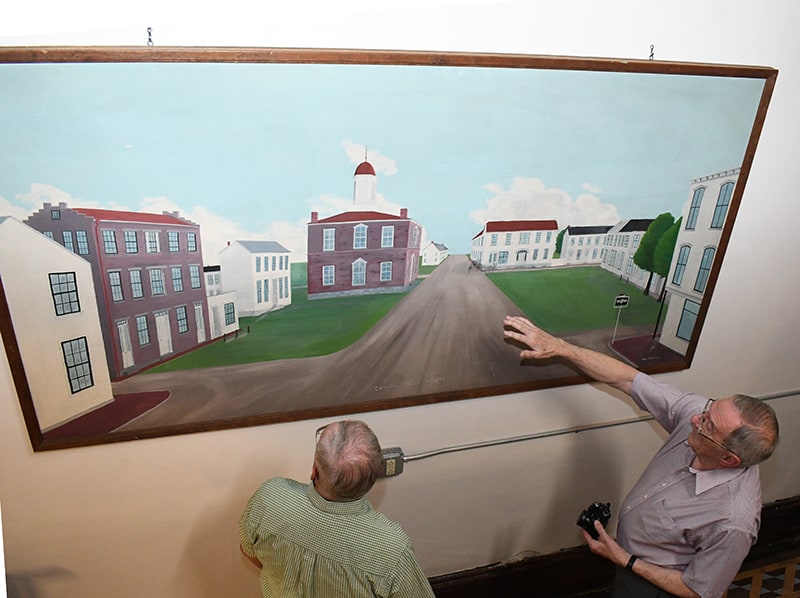330-476-6343 | [email protected]

330-476-6343 | [email protected]

Editor’s note: The following story is the first part of a two-part series on a painting of downtown Carrollton with a history that dates back to the late 1950s. Part one is the story of the artist and his son’s search to find the unfinished painting after nearly 70 years. Part two will focus on the completion of the painting by the original artist’s grandson.
In the late 1950’s, Carrollton artist Joe Butler turned the family’s living room of their 2nd St. NE, Carrollton, home into a studio.
According to his son, Don Butler, his father’s goal was to create a painting of downtown Carrollton as it appeared in the early days of the village’s existence. His canvas was a 4×8 sheet of Celotex.
“In those days, Celotex was an interior board for walls, was cream-colored and smooth,” said the younger Butler on a recent visit to Carrollton. “Dad found he could buy it for a reasonable price at lumber stores in 4×8 sheets.”
Don, who was a youngster in the late 1950s, remembers his father setting up a ladder in the living room of the family’s home and working on the painting.
“It was the largest one he did,” Don noted. “He was a well-known local artist. He did the painting of the Carrollton Warriors mascot in the middle of the Bell-Herron gymnasium.
“This painting was a pretty stark engraving,” he said. “In those days, you didn’t have photos so you painted from memory so there were not many trees, shrubs or bushes in the painting. I remember one day he walked in the room, looked at the painting and said maybe he should add some people. He sketched in the carriage, horse and people.”
Carroll County Commissioner Bob Wirkner, who is leading the effort on the county’s part to have the painting finished, believes Joe Butler used a sketch of Carrollton created by Henry Howe as his reference for the work. Howe’s drawing is of the downtown Carrollton area in the 1850s era and is included in his History of Ohio, Volume 2.
“There are a lot of downtown buildings in the painting, all of which mimic the sketch of Howe,” said Wirkner.
Don believes his father was working on the paining for the village’s sesquicentennial celebration, scheduled for the summer of 1965.
On July 29, 1960, Joe Butler died suddenly of a heart attack before his painting was finished. Several of the buildings Several of the buildings were complete, while others still showed the original pencil sketches of part of the structures. The carriage and people, located near a building at the top of the painting, remained a pencil sketch.
That was not the end of the painting. The large, unframed and unfinished work of Joe Butler on the Celotex board left the family’s living room for its new home, The Poole Insurance Agency on Public Square.
The business was owned by three family members and named for Cree Bulter Poole.
Many are residents will remember the painting gracing the wall in the McFadden Insurance Agency, which was formerly the Poole Insurance Agency.
The business was owned by three family members and named for Cree Butler Poole.
Many are residents will remember the painting gracing the wall in the McFadden Insurance Agency, which was formerly the Poole Insurance Agency. At some point, the painting was removed from the insurance office wall and spent time at the Carroll County Arts Center and the Carroll County Chamber of Commerce. The painting recently found a new home on the second floor wall of the county courthouse.
Don said one day he was thinking about the painting, began wondering what became of it, and sent his friend, Al Kemerer of Carrollton, in search of the artwork.
Kemerer located the painting in the courthouse and reported back to Don who approached commissioners with an idea: to have his son, Curtis Butler, a professional artist, finish the work his grandfather began nearly 75 years ago.
Wirkner pitched the idea to his fellow commissioners, Chris Modranski and Donald Leggett, and the three gave the project their stamp of approval.
Don and his wife, Beverly, made the trip from their home in Howland to Carroll County recently to discuss the project and view the painting for the first time in many years. Commissioners suggested an area be set up for Curtis to finish the painting at the courthouse. Curtis, a professional artist in Gastonia, NC, preferred to have the painting shipped to North Carolina where he could work on it in his studio. Don and Beverly volunteered to cover the shipping costs.
Arrangements were made for Curtis’ currier company to pick up the painting in Carrollton and drive it to Butler Studio. The third week in July, the painting was removed from the wall in the courthouse to begin the journey toward its new life.
Interested in a monthl roundup of stories? Enter your email to be added to our mailing list.
